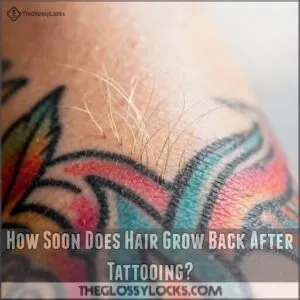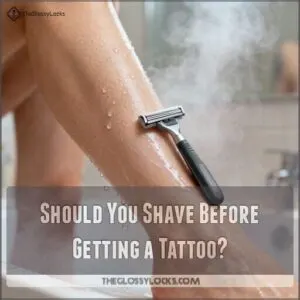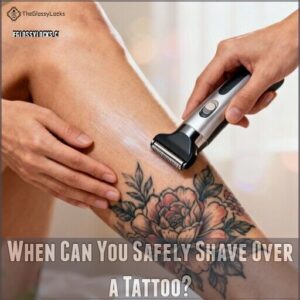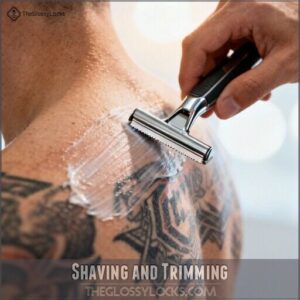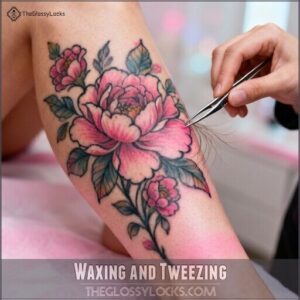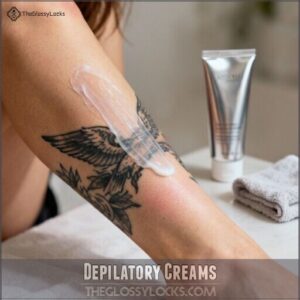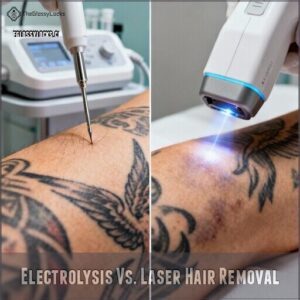This site is supported by our readers. We may earn a commission, at no cost to you, if you purchase through links.
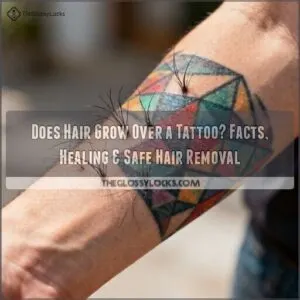
Within a few weeks of getting tattooed, you’ll notice hair growing back through the colored skin as if nothing happened. Understanding how your skin layers interact with both tattoo ink and hair growth helps you know what to expect during healing and how to care for your tattooed skin long-term.
Table Of Contents
- Key Takeaways
- Does Hair Grow Over a Tattoo?
- How Soon Does Hair Grow Back After Tattooing?
- Should You Shave Before Getting a Tattoo?
- When Can You Safely Shave Over a Tattoo?
- What Hair Removal Methods Are Safe for Tattoos?
- Does Scalp Micropigmentation Affect Hair Growth?
- Frequently Asked Questions (FAQs)
- Are tattoos permanent?
- Can I get a tattoo if I have sensitive skin?
- Does getting a tattoo hurt?
- Is there a risk of infection when getting a tattoo?
- How often should I moisturize my tattoo?
- Can you wax immediately after tattoo removal?
- How does body hair affect tattoo visibility?
- Do tattoos fade faster in hairy areas?
- Can hormonal changes affect tattoo hair growth?
- Will tattoo touch-ups require re-shaving the area?
- Conclusion
Key Takeaways
- Hair grows back normally over tattoos because the ink sits in the dermis layer (1-2 millimeters deep) while hair follicles anchor themselves in the deeper subcutaneous layer, meaning the tattooing process never reaches or damages the roots that produce hair.
- You should wait four to six weeks after getting a tattoo before shaving over it, as shaving too early can introduce bacteria into healing tissue, cause ink fading, delay recovery, and potentially create scarring.
- Once your tattoo has fully healed, you can safely use most hair removal methods including shaving, trimming, waxing, and tweezing, though electrolysis is safer than laser hair removal for permanent removal since lasers can affect tattoo pigment and cause fading.
- Scalp micropigmentation (scalp tattoos) doesn’t prevent hair growth because the pigment is applied only 2 millimeters deep into the uppermost scalp layer, which stays above the hair follicles and allows existing hair to continue growing normally.
Does Hair Grow Over a Tattoo?
If you’re considering getting a tattoo in a spot where hair already grows, you’re probably wondering what happens next. The good news is that tattoo ink doesn’t stop your hair from doing its thing.
Let’s look at how tattoos and hair follicles actually work together.
Tattoo Ink Placement and Skin Layers
When your tattoo artist applies ink to your skin, they’re working in a specific layer called the dermis, which sits just above where your hair follicles live. This dermis layer holds the pigment stability needed for your tattoo to last, while the epidermis layer above it constantly sheds and renews.
Here’s what happens during skin penetration:
- Ink depth matters: The needle penetrates about 1-2 millimeters into dermal layers, depositing tattoo ink between cells.
- Follicle proximity is key: Your hair follicles sit deeper than where pigment settles, so tattoo ink absorption won’t disrupt growth.
- Dermal placement prevents tattoo fading: Surface cells turn over, but dermis holds ink permanently without affecting follicle function.
Hair Follicle Structure and Function
Your hair follicles are anchored deep in the skin’s subcutaneous layer, far below where tattoo ink settles, which is why they keep doing their job without interruption. Each hair follicle contains a dermal papilla that nourishes the growth cycle, ensuring your hair types continue developing through distinct phases—growth, rest, and shedding.
| Follicle Component | Function |
|---|---|
| Dermal Papilla | Supplies nutrients for hair growth |
| Hair Follicle Root | Anchors hair in dermis layer |
| Epidermis Layer | Protects follicle opening |
This follicle anatomy stays intact because tattoo needles don’t reach deep enough to compromise follicle health.
Scientific Evidence on Hair Growth Over Tattoos
Studies confirm that tattoo ink placement in the dermis doesn’t disrupt hair follicles located deeper in the subcutaneous layer. Research shows:
- Hair regrowth occurs within 2–3 weeks after tattooing
- No permanent hair loss happens in healthy skin
- Temporary density changes result from skin trauma, not follicle damage
- Wound healing responses may activate hair growth pathways
- Hair texture and thickness remain unchanged long-term
Because tattoo ink is deposited in the dermis, it generally doesn’t impact hair follicle roots. Your hair growth cycle resumes normally once dermal healing completes, with removal safety depending on proper timing.
How Soon Does Hair Grow Back After Tattooing?
After getting a tattoo, you’re probably wondering how long you’ll wait before your hair makes its comeback. The good news is that hair usually grows back within two to three weeks, though this timeline can vary based on your body’s unique characteristics.
Let’s look at what influences how quickly your hair returns and what patterns you can expect during the regrowth process.
Typical Hair Growth Timeline
Most people notice their hair starting to peek through the tattooed skin within two to three weeks after getting inked. This initial regrowth follows your natural hair cycle, which continues without interruption.
Full recovery of hair growth usually occurs within four to six weeks, though individual variation means some people see faster or slower regrowth depending on their hair growth rate and hormonal influence.
Factors Affecting Hair Regrowth Rate
Several biological and environmental factors influence how quickly your hair comes back after tattooing. Genetics play the biggest role, determining up to 80% of your hair growth rate and thickness. Hormones, nutrition, tissue injury, and health conditions also shape the hair cycle and regrowth timeline. Scalp tattoos, however, don’t impact hair follicle growth.
- Genetics: Family history of pattern baldness can slow hair regrowth, affecting over 50% of men by age 50
- Hormones: Thyroid imbalances or postpartum changes may delay regrowth by up to 25% during dysfunction periods
- Nutrition: Iron or zinc deficiency reduces hair regrowth speed by 20% to 34% until corrected
- Tissue Injury: Tattooing shifts 85% of nearby hair follicles into a temporary resting phase
- Health Conditions: Autoimmune disorders or medications can intermittently inhibit hair follicles’ normal function
Hair Growth Patterns After Tattooing
Once the tattoo heals, your hair doesn’t change its pattern—it grows back exactly where it did before, following the same direction, density, and texture you’ve always had. The tattoo location and hormonal influence don’t alter your hair follicles’ inherent characteristics.
Individual variation means your hair regrowth continues following its natural cycle, with no regrowth abnormalities occurring from the tattooing process itself.
Should You Shave Before Getting a Tattoo?
Yes, you should shave before getting a tattoo. Most tattoo artists will shave the area themselves if you don’t, but arriving with clean, hair-free skin helps them prepare your skin more efficiently.
Let’s look at what you need to know about shaving before your tattoo appointment.
Tattoo Preparation Best Practices
Preparing your skin the right way before your appointment can make the difference between a smooth tattooing experience and an uncomfortable one. Keep your skin hydrated by drinking water regularly and moisturizing the area for a few days before your consultation. Avoid irritants like sunburn and exfoliation immediately beforehand, as these can affect the tattooing process.
Your tattoo artist consultation will address specific pre-tattoo preparation needs, ensuring tattoo hygiene and safety remain top priorities.
Risks of Not Shaving Before Tattooing
Skipping the pre-tattoo shave isn’t just inconvenient—it can compromise your tattoo’s quality and increase infection risk. Hair blocks the tattoo artist’s view, making ink visibility difficult and creating uneven lines or patchy tattoos.
The tattoo process can trap bacteria against hair follicles, raising infection risk. Hair removal through proper shaving before your appointment protects against follicle damage and ensures clean tattoo preparation.
Tattoo Artist Recommendations
Most professional tattoo artists won’t let you walk into their studio with unshaved skin—they’ll manage it themselves to maintain proper hygiene standards and assure the best possible results. Here’s what reputable artists usually do during tattoo preparation:
- Shave the area carefully using a clean, sterile razor to prevent infection and assure clear visibility of your skin.
- Explain aftercare advice thoroughly, including when you can safely shave over your new tattoo and which hair removal methods to avoid.
- Answer your client concerns about hair regrowth, tattoo design placement, and how body hair affects the final appearance of your tattoo.
When Can You Safely Shave Over a Tattoo?
You shouldn’t shave over a fresh tattoo until your skin has completely healed, which usually takes four to six weeks. Shaving too soon can damage the healing tissue, increase infection risk, and potentially affect how your tattoo looks.
Here’s what you need to know about the healing process and when it’s safe to pick up your razor again.
Tattoo Healing Stages
Your tattoo goes through several distinct stages of healing, each with its own timeline and characteristics. The initial inflammation phase lasts 1-3 days, bringing redness and swelling.
Next, the scabbing process begins as your skin heals the wound, usually lasting 1-2 weeks. During this time, you’ll experience itching, but proper itch management is essential—don’t scratch. Watch for infection signs like excessive discharge or worsening pain.
Complete skin healing takes 4-6 weeks, though long-term care protects your tattoo aftercare investment for years.
Signs Your Tattoo is Fully Healed
After healing stages run their course, you’ll know your tattoo is ready when certain clear markers appear. Redness absence signals the skin healing process is complete—the area should match your surrounding skin tone with no warmth. Sensitivity gone means no discomfort when you touch or wash the tattoo. Texture settled shows smooth, even skin without scabs or flaking. Ink appearance becomes vibrant and consistent.
Timeline benchmarks suggest surface wound healing finishes around 4 weeks, though deeper tattoo healing continues for months.
Risks of Shaving Too Early
Jumping the gun on shaving can undo weeks of careful healing and leave you with problems that are easily avoided. Shaving too early exposes vulnerable skin to razor burn and bacteria that trigger infection risk. Your tattoo healing timeline depends on proper aftercare, and rushing it invites complications that affect both appearance and comfort.
Early shaving dangers include:
- Infection risk from bacteria entering open or partially healed skin
- Ink fading when blades disrupt the settling process beneath the surface
- Delayed healing as irritation restarts inflammation your body already resolved
- Scarring from blades catching raised scabs or sensitive tissue
What Hair Removal Methods Are Safe for Tattoos?
Once your tattoo is fully healed, you can safely remove hair using several methods. Each approach has its own benefits and considerations, especially for protecting your ink.
Let’s look at the options that work best for keeping both your skin and tattoo in good shape.
Shaving and Trimming
Once your tattoo has fully healed—usually after four to six weeks—you can safely shave over it just like you’d any other part of your skin. Use a clean, sharp razor and proper shaving technique to prevent ingrown hairs and irritation.
| Aspect | Recommendation |
|---|---|
| Razor hygiene | Use fresh, clean blades for each shave |
| Shaving frequency | Shave as needed without concern |
| Aftercare routine | Apply gentle moisturizer post-shave |
Trimming tools work equally well if you prefer maintaining shorter hair without a full shave.
Waxing and Tweezing
Waxing and tweezing offer longer-lasting results than shaving, but they require extra caution when working around your tattoo. Both methods pull hair from the follicles, which can stress your skin. Wait until your tattoo is completely healed before trying either technique.
Waxing may cause more discomfort on tattooed areas due to increased skin sensitivity, while tweezing works well for managing smaller sections and reducing ingrown hairs.
Depilatory Creams
Depilatory creams work by dissolving hair at the skin’s surface using chemicals, offering a pain-free alternative to waxing or tweezing. However, the cream ingredients can trigger skin irritation or allergic reactions, especially on sensitive tattooed areas.
Test the product on a small patch of skin first, and avoid application if your tattoo shows any signs of fading or irritation. Follow the application technique instructions carefully to minimize risks.
Electrolysis Vs. Laser Hair Removal
Regarding permanent hair removal over tattoos, understanding the differences between these methods matters for your ink’s safety. Electrolysis uses a hair-sized probe to destroy individual follicles with minimal electricity, making it safe for tattooed skin without risking tattoo fading. Laser hair removal, however, targets pigment in hair follicles but can also affect tattoo ink, potentially causing fading or discoloration.
Consider these factors:
- Electrolysis safety: Precise follicle targeting protects your tattoo
- Laser effectiveness: Works faster but risks tattoo damage
- Treatment cost: Electrolysis requires more sessions, increasing expense
- Skin types: Electrolysis works universally; lasers vary by hair and skin tone
Does Scalp Micropigmentation Affect Hair Growth?
Scalp micropigmentation, often called a scalp tattoo, works differently than traditional tattoos because it’s designed specifically for the scalp. You might wonder if this procedure affects your ability to grow hair or damages the follicles underneath.
Let’s look at how the procedure works, what happens to your hair follicles, and how it’s used to address hair loss.
Scalp Tattoo Procedure Explained
The practitioner applies pigment about 2 mm deep into your scalp’s uppermost layer, which sits above where your hair follicles live. Most people describe the sensation as tolerable, similar to getting a regular tattoo.
This procedure usually takes two to three sessions to complete, with each session lasting a few hours depending on the treatment area. Results from scalp micropigmentation can last several years before you’ll need a touch-up to maintain the appearance.
Impact on Hair Follicles
Your hair follicles remain safe during scalp micropigmentation because the pigment goes in shallow, about 2 mm deep. This placement avoids follicle trauma risk and preserves follicle viability, so hair growth over tattoos continues normally.
The ink composition effects and immune response don’t interfere with your follicles’ natural function. Even if you have existing hair, it won’t stop growing after the procedure, and scarring impact is minimal with proper technique.
Scalp Micropigmentation for Hair Loss
If you’re dealing with thinning hair or pattern baldness, scalp micropigmentation offers a way to create the appearance of a fuller head of hair without surgery. This scalp tattoo procedure helps with hair loss by creating the illusion of shaved hair follicles, masking areas of thinning.
SMP realism depends on pigment quality and practitioner skill, with SMP longevity lasting three to five years before touch-up needs arise, though cost analysis varies.
Frequently Asked Questions (FAQs)
Are tattoos permanent?
Yes, tattoos are permanent, though the ink doesn’t stay exactly as it was.
Pigment in the dermis layer can fade over time, which is why touch-ups may be needed to maintain the tattoo’s appearance.
Can I get a tattoo if I have sensitive skin?
You can get a tattoo if you have sensitive skin, but patch testing is essential. Ask your tattoo artist to test the ink ingredients on a small skin area first to check for allergy risks and guarantee proper aftercare for your skin conditions.
Does getting a tattoo hurt?
Let’s not beat around the bush: tattooing does cause discomfort, but pain perception varies greatly among individuals. Tattoo placement matters a lot, as areas with less fat or muscle feel more intense.
Your individual tolerance, the tattoo size, and pain management techniques all influence your experience during the tattooing process when the tattoo needle creates skin penetration.
Is there a risk of infection when getting a tattoo?
Any tattoo poses an infection risk since tattooing involves needles breaking your skin’s protective barrier. Proper hygiene practices and diligent aftercare greatly reduce infection complications.
Watch for symptoms like excessive redness, swelling, warmth, or discharge, which signal healing problems requiring medical attention.
How often should I moisturize my tattoo?
During the first two to three weeks of tattoo healing, apply a thin layer of fragrance-free moisturizer two to three times daily.
Once healed, you can reduce this to once daily for long-term skin care and maintenance.
Can you wax immediately after tattoo removal?
No, don’t wax immediately—your skin needs time. Waxing risks tearing fragile tissue, causing infection, and disrupting the healing timeline.
Wait until the tattoo heals completely, usually 4-6 weeks, before any hair removal beyond gentle shaving.
How does body hair affect tattoo visibility?
Body hair impacts tattoo visibility in several key ways. Dense hair growth can obscure fine details and shading in your tattoo design, making intricate patterns harder to see. Hair color contrast plays a significant role—dark hair on light tattoos creates more visual interference than lighter hair.
Tattoo placement effects matter too, since areas with thicker body hair naturally reduce perceived tattoo clarity. Hair styling influence and overall hair density impact how well your body art shows through, affecting both tattoo visibility and accuracy of the original design’s appearance.
Do tattoos fade faster in hairy areas?
Like sunlight bleaching a favorite t-shirt, hairy areas can slightly accelerate tattoo fading. This is due to increased friction from hair growth, trapped sweat near hair follicles, and sun exposure if you don’t keep the area covered or protected properly.
Can hormonal changes affect tattoo hair growth?
Hormonal changes can greatly impact hair growth patterns over your tattoo because hormones regulate hair follicles and hair cycles.
Hormonal imbalances may slow regrowth or trigger conditions like alopecia, though this affects your overall hair—not the tattoo itself.
Will tattoo touch-ups require re-shaving the area?
Most touch-ups need re-shaving, especially if hair density increased since your original tattoo. Your artist will shave the area again to see the design clearly and work safely.
Shaving frequency depends on hair regrowth and tattoo maintenance needs.
Conclusion
Your tattoo becomes a permanent part of your skin, yet hair doesn’t hesitate to reclaim its territory. That’s the beauty of biology—two systems occupying the same space without interfering with each other.
Now that you understand does hair grow over a tattoo and how to manage that growth safely, you can maintain both your ink and your grooming routine without worry. Wait until your tattoo heals completely, choose hair removal methods that protect the pigment, and your body art will stay vibrant for years to come.
- https://scandinavianbiolabs.co.uk/blogs/blog/do-tattoos-stop-hair-growth-skin-modification-effects
- https://www.ulike.com/blogs/hair-removal/does-hair-grow-over-tattoos
- https://www.scalpmastersri.com/blog/will-a-hair-tattoo-affect-my-hair-growth
- https://pmc.ncbi.nlm.nih.gov/articles/PMC10015113/
- https://my.clevelandclinic.org/health/treatments/22719-scalp-micropigmentation

